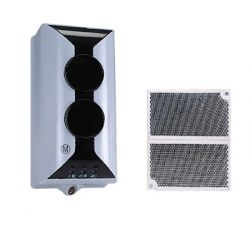Beam Detectors And Where They Should Be Sited !
Beam Detectors And Where They Should Be Sited !
Beam Detectors are a well established product available in the fire alarm industry. Commonly beam detectors are used to provide automatic fire detection in large open spaces, such as warehouses, airports and factories.
A beam detector works by having a transmitter and receiver. The transmitter part of the beam detector fires out an infrared beam which is then received by the receiver. The beam detector is designed to set a fire alarm system into alarm when a pre-set level of smoke obscurs the infrared beam. Beam detectors are available in two types, these are reflective beam detectors and point to point type beam detectors. A reflective beam detector works by firing the infrared beam from a transmitter at a reflector positioned at the other end of the area being covered by the beam detector, the beam is then reflected back towards the beam detector unit which also has a receiver built into the enclosure. A point to point beam detector operates by having a dedicated transmitter located at one side of the area being covered by the beam detector and then having a dedicated receiver at the other end of the protected area.
One major advantage of beam detectors is that they can be located a much greater heights than standard point detectors. The maximum mointing height of a point detector is 10.5 metres where as BS5839 recommends that beam detectors can be mounted up to a height of 25 metres. Another advantage of a beam detector is that one beam detector can provide automatic fire detection for an area which would require several standard point detectors, which means that using beam detectors can be much more cost effective than using standard point detectors.
The Siting of Beam Detectors
- Beam Detectors can be used at heights of up to 25 metres
- For apex ceilings extended coverage can be achieved by 1% for each degree of angle
- Beam Detectors should be positioned within 600mm of the highest point of the ceiling
- Ceiling beams close to walls (500mm) or temporary obstructions should be avoided
- Transmitters & Receivers should be mounted on solid surfaces which are not effected by wind or natural temperature changes
- Additional units may be included in atria to detect at lower levels, to counter statification effect

For More Information On These Products Please Click The Following Link:- Beam Detectors






